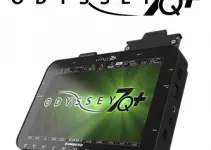Crazy times call for crazy….shootouts! And what could be a crazier battle than the one between a high-end cinema camera, known as a staple in most of the big movies and tv-series all over the world, the sweet little dream of filmmakers everywhere, a RED camera, and a less-than-a-pound smartphone with a sensor smaller than a fingernail?
Yes, it’s true that what we have here is one of the flagship phones from Samsung, but we’re quite sure that even in the Korean headquarters if anyone tried to propose such a comparison they would have been laughed off.
It’s true that as gearheads we’re prone to get enthusiastic about technology’s development, and one day for sure we’ll film only with a camera that we can hold in our pocket, but could it be that the day is already here? Potato Jet has tried this insane comparison, and here we are about to see the results.
The first contact with the phone is better than expected. Samsung has made a lot of progress on the photographic side, adding three lenses of different focal lengths on the back, so that the phone is capable of using the three lenses to manipulate shots with some photo-processing algorithm, producing some truly amazing result on the photographic side.
It can select the subject isolating it both in color and focus creating a soft bokeh right behind it and getting it to pop out. But it’s not the first time we see this kind of effect on a smartphone, Pixels and iPhones have had it for ages now as many other high-end devices. The real question we all want to know the answer is: how does it shoot video?
Well, right off the bat the answer is: better than expected. The phone produces up to a 60fps 4K file starting from a minimum frame rate of 30 in the default camera app, if you want to shoot in lower framerates (24 or 25fps) they can be unlocked only with third-party apps.
The images are unbelievably good when you take a first look at them: sharp and crisp, with a nice color gamut, very pleasant to watch, these clips watched side by side may trick the non expert viewer in thinking that the images of the RED are a bit too dull and flat, but a more expert eye knows that this is a design choice, the log image is recorded with a post-production in mind, when the final clip will be graded to get the most out of it.
That said the dynamic range of the phone is still quite impressive. A shot at the sunset with the sun in the frame is able to retain a good skin tone on the subject in the shadows, there is even an HDR10+ capability in the camera, aimed most of all to YouTube uploads, although it’s not of much use in today’s viewing devices.
The feeling of watching the clips side-by-side is strange. The video from the phone seems to be (for lack of a better word) decent, but not quite there.
The images are indeed beautiful, but while a cinema camera gives you the ability to adjust any kind of setting for the image, with the S10+ instead (or with any other phone, in fact), you are tied to the algorithmically beautiful images the chipset inside the phone decides are right at that moment.
The form factor is a great convenience indeed. When shooting on a phone it would be very rare to have someone nosing around and asking for permits or just standing by for simple curiosity, maybe expecting to see some celebrity, because we all know, where there’s a cinema camera there must be a serious shooting going on, right?
Not only that, the ability to share directly on the cloud the images you just got, the ease in the portability and the power management… There are many positives in the idea of a smartphone as a shooting device. And we have not even mentioned the fact that these new devices have super slow-motion capabilities, this S10+ tops at an incredible 960fps. That’s insane! So you may ask, why are we not using them more?
The real problem is that the images of this smartphone appear to be super-sharp but in fact, they lack in detail. The over-sharpening that is applied digitally to the footage is there to compensate for the lack of real detail.
Sometimes it gives a very nice result, sometimes you’ll see artifacts coming out on people’s skin due to this kind of digital sharpening, and although the digital voodoo magic of software algorithm can produce beautiful bokeh in photos, in video we are still a long time away from that. No camera phone can think of emulating a full-frame or even S35 sensor and the character of a prime lens.
So games and silly shootouts aside, it is true that technology has come a long way, cramping a pack of features in this small devices, and surely the future will bring us better sensors, better quality images and we’ll see the industry evolve again, but as for now you can stay calm, it’s still not time to put your cinema camera on the shelf.
[source: Potato Jet]
Disclaimer: As an Amazon Associate partner and participant in B&H and Adorama Affiliate programmes, we earn a small comission from each purchase made through the affiliate links listed above at no additional cost to you.
Claim your copy of DAVINCI RESOLVE - SIMPLIFIED COURSE with 50% off! Get Instant Access!





